I’m quite sorry for disappearing for so long… first I had lots of computer problems that took up months, and then I felt bad for abandoning it for so long so I just left it. I do have some things to post though, starting with this.
2022 Update: Images and links fixed.
- Title: Hexcite: The Shapes of Victory (US/EU), Glocal Hexcite (Japan)
- Developer: Gu Inc., Gaijin
- Publisher: Landwarf/NEC (Japan), Ubisoft (US/EU)
- Released: 1998 (Japan), 1999 (US/EU)
- Platform: Game Boy / Game Boy Color dual mode game
Hexcite is a great and very addictive Game Boy / Game Boy Color dual-mode game with Super Game Boy support. It is a board game conversion of the board game Hexcite (shockingly enough). While several Hexcite titles have released in Japan, the US only has gotten the GBC and PC download ones (I will mention more about the PC version later). The game does have battery save, unlike many GB puzzle games. I mean it when I say it’s addictive — I played at least a match of this game almost every day for months and months after buying the game, and it is easily my most played game of 2011. I can’t say I’ve done that for too many games before… this game is really, REALLY addictive.
Unfortunately, some other versions of the game stayed in Japan. The game was originally a Japanese board game, but I’m not sure how much Western distribution the boardgame version had or has. Other console ports include a (B&W) Wonderswan version in 2000 (Glocal Hexcite, very much like the GB version), a Playstation version in 1999 (Glocal Hexcite, but enhanced for the more powerful system I think), and a Game Boy Advance version in 2001 (Hexcite: Metal Fusion EX, with new features and such), as well as a cellphone version in the mid 2000s (Hexcite Fusion); this last, cellphone version seems to have been released in the US on some carriers, according to Gamespot, but I don’t know for sure. I would love to play them, and will probably at least play the GBA and PSX versions sometime. They look like they have more features than the first game, I’d love to see what they are.
The West finally got another major Hexcite game in 2007, when a PC version was released. It’s a download only title on Bigfish Games. I will discuss that game after I cover the GB version and the basics of gameplay. http://www.bigfishgames.com/download-games/1357/hexcite/index.html
Here is how the game works. Hexcite is a puzzle strategy game. In the game, two players take turns filling in a large hexagon with shapes. The large hexagon is broken into seven smaller hexagons, each of which is broken up into a lot of triangles. There are seven different pieces that the players use to fill in the space. You can rotate pieces to angle them any possible way they could fit. In each game, the players get a somewhat random selection of pieces and try to score the most points. The rules are a little complex, but once you get used to it it makes sense, and I became able to quickly see where I could play my pieces, and where I couldn’t.
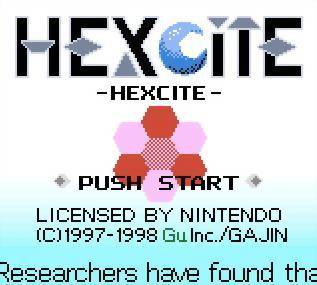
Start Screen. The text at the bottom scrolls.
Hexcite is a great and very addictive Game Boy / Game Boy Color dual-mode game with Super Game Boy support. It is a board game conversion of the board game Hexcite (shockingly enough). While several Hexcite titles have released in Japan, the US only has gotten the GBC and PC download ones (I will mention more about the PC version later). The game does have battery save, unlike many GB puzzle games. I mean it when I say it’s addictive — I played at least a match of this game almost every day for months and months after buying the game, and it is easily my most played game of 2011. I can’t say I’ve done that for too many games before… this game is really, REALLY addictive.
Unfortunately, some other versions of the game stayed in Japan. The game was originally a Japanese board game, but I’m not sure how much Western distribution the boardgame version had or has. Other console ports include a (B&W) Wonderswan version in 2000 (Glocal Hexcite, very much like the GB version), a Playstation version in 1999 (Glocal Hexcite, but enhanced for the more powerful system I think), and a Game Boy Advance version in 2001 (Hexcite: Metal Fusion EX, with new features and such), as well as a cellphone version in the mid 2000s (Hexcite Fusion); this last, cellphone version seems to have been released in the US on some carriers, according to Gamespot, but I don’t know for sure. I would love to play them, and will probably at least play the GBA and PSX versions sometime. They look like they have more features than the first game, I’d love to see what they are.
The West finally got another major Hexcite game in 2007, when a PC version was released. It’s a download only title on Bigfish Games. I will discuss that game after I cover the GB version and the basics of gameplay. http://www.bigfishgames.com/download-games/1357/hexcite/index.html
Here is how the game works. Hexcite is a puzzle strategy game. In the game, two players take turns filling in a large hexagon with shapes. The large hexagon is broken into seven smaller hexagons, each of which is broken up into a lot of triangles. There are seven different pieces that the players use to fill in the space. You can rotate pieces to angle them any possible way they could fit. In each game, the players get a somewhat random selection of pieces and try to score the most points. The rules are a little complex, but once you get used to it it makes sense, and I became able to quickly see where I could play my pieces, and where I couldn’t.
On that note, for scoring, you get five points for each side of the polygon you are placing that is touching already placed pieces on the board. However, you are docked for each piece still in your inventory at the end of the game. You lose five points for each side the shape has, so a triangle loses you 15 points while a hexagon loses you 30. You must play a piece if you have a play, even if it allows the other player to get more points off of it; you can’t pass. So, you need to use strategy when deciding which pieces to play where. Sometimes, it’s best to play somewhere that blocks you from being able to play there; even if you lose 20 points on that piece, that’s better than giving the other player 30.
When it comes to playing your pieces, however, and this is important, you can only play if all sides of the polygon you’re playing are either fully empty or fully against other pieces. That is, you can’t place a piece if a side of the piece you’re playing is only halfway against other blocks. Each side must either be against empty space, or fully against placed sides. This rule takes some getting used to, but you’ll get it eventually.
Also, the player who plays the last triangle in one of the six outer large hexagons on the map and fills it up gets a point bonus. Three are worth 10 points, the other three 30; this is marked on the board with the three or one dots around the edge next to each triangle. The two types are colored differently on the field as well, varying depending on which colors you have chosen in the options menu. There is no bonus for filling the central hexagon.
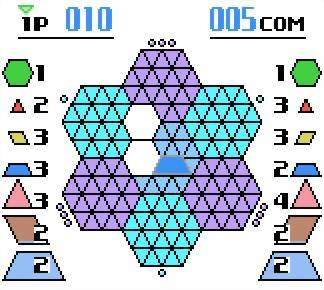
The playfield, with two hexagons placed and the player considering where to put a small trapezoid.
The seven pieces are shown on the dies of the picture above. These take up a lot of space, but because each side is only one piece long, you’ll have no issues with sides being partially covered at least.
First there is a large hexagon that fills up six spaces on the board. This is a large piece, and with six sides the most costly to not play. Because all sides are only one space long, though, you won’t need to worry about whether the sides are fully covered, only that there is enough space.
Second is a small triangle, which fills up one space on the board. It’s always good to have a good number of these. Very useful pieces.
Third is a small rectangle. Two spaces. These can be quite useful.
Fourth is a small trapezoid. Three spaces. A good piece, but a bit harder to play than the small rectangle.
Fifth is the large triangle. Four spaces. The smallest of the big pieces, but remember they only have three sides.
Sixth is the large rectangle — two large triangles end to end. Eight spaces. Three of these fill up a hexagon on the board.
Last is the large trapezoid, three large triangles. These are the biggest pieces and the hardest to play — each takes up a full half of a hexagon on the board. Play these first, or you likely never will. And be afraid when you have a lot of them and the computer starts with a hexagon, you’ll lose a lot of points if you’re unlucky. It still is only four sided though, size has no effect on how much you lose if you don’t play it.
Remember, size has no effect on point loss, only the number of sides, so small and large rectangles and half hexagons will all cost you 20 points if there are any left at the end, for instance. So don’t focus on playing all large pieces first, then smaller ones — there are many cases where it’s smarter to play the small rectangles and trapezoids before the large triangles, as they cost more points if left in your hand.
So, those are the game basics and rules. Now, on to game modes.
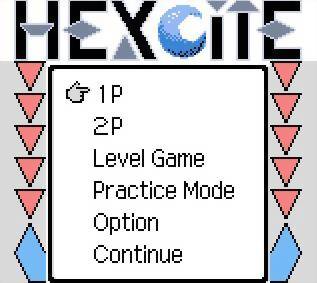
Main Menu
The game has One Player, Two Player, Level Game, and Practice mode modes, as well as an options screen. Continue is for continuing a game you suspended — yes, you can stop a match in progress and continue it later in this game, which is awesome, that isn’t common on the GB or GBC.
One Player (1P) mode is for playing a single match; think of this as the quick-action mode. You just choose a number of rounds, difficulty, a few more options (timer on/off, alternate starts or you always play first) and go. There are five difficulty level choices. It won’t be saving stats or anything, though if you win enough games without saving in the highest difficulty level, on a GBC, you will unlock another difficulty level above that. This is the one thing I haven’t managed to do yet in the game, though I am trying.
Two Player (2P) mode is for a versus game. It’s like one player but with two humans, obviously. As this is a turn-based game, you can play two player on a single Game Boy, taking turns, if you wish. If you’re playing on a Super Game Boy, the game supports using two SNES controllers, so that each player can use a separate controller. It’s a nice option. For handheld systems it also supports link cable multiplayer if you wish to play it that way. Basically, the game supports every multiplayer method it possibly could have on the platform. Great work. As a great board game should be, this is a fantastic multiplayer game.
Level Gameis the main single player mode. In this mode you save your progress into one of six slots as you go. In each match you can choose the number of rounds; the default is six, which is what I usually go with, but you can choose any round number between two and ten. You gain experience as you win rounds. The game also has ranks, as the main goal here is to work from the bottom rank, E5, up to Master. This took me a while to figure out, perhaps because I do not have the manual and this is not explained ingame, but you gain ranks not just through experience, but primarily through consecutive wins. On the load screen, you’ll see a row of dots, or stars, at the bottom. Each time you win a round, you get a star; if you lose, you lose the stars and the go back to blank dots. So, in order to move up a rank, you need to get that number of wins in a row. At first you’ll only need three wins to rank up, but by the end of the game you need seven. These do carry over from match to match, though, so if you end a match winning three in a row, you just would need to win four straight to rank up at the end. Winning many rounds in a row is not easy, so the farther you get, the harder it gets to progress. You can sort of manipulate it by just playing two round matches and such of course, but still, it’s a good challenge. As a result, it will take a good amount of time before you hit the max rank, Master, and complete the level game. I played this mode the most by far.
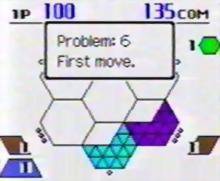
Practice Mode. Fill the space with only the provided pieces.
Practice mode isn’t quite what it sounds — actually, it is basically the puzzle mode. See the picture below — you get specific pieces and try to win. There are sixty puzzles to solve. I usually hate puzzle modes in puzzle games (you know, the ones where you have to use just a few pieces to clear the board), but this one is fun. Each puzzle starts with the field mostly full and points at preset values, and you have to figure out how to win with the few plays you have. Some of them are tricky, but I eventually got through them all. I was surprised to enjoy this mode, because usually I can’t stand modes like this, but with this kind of game, it works great. In a game like Puzzle League/Tetris Attack I don’t like the puzzle mode at all, and am quite terrible at it, but here it is good. I still would rather play the main game even in Hexcite, but at least I had fun and finished all the puzzles; I’ve never done that in a Puzzle League game. So, despite my issues with the concept, it’s great to have Puzzle mode, and it is surprisingly good.
In the Options screen, the main options of note are the music and color set choices. There are ten music tracks and eight different color sets to choose from, and the SGB and GBC each have their own different color sets. Many GB or GBC puzzle games would have two or three music tracks and one color set, and no battery save either, but this is a better, more feature-rich effort, and I like that about this game — it feels much more complete and like a bigger effort than most other puzzle or board games on the console. On SGB there are fewer colors on screen of course, but still it does a good job and the game is fun on a television. I’m not sure whether I like the GBC or SGB versions better; the main reason that I mostly play on GBC (well, GBA SP that is) is because I like playing this game while watching TV, and you can’t do that with the SGB version. There’s a nice help menu here as well with a good, visual tutorial of how to play the game and the rules for the various modes. There are also a few messages from some of the developers, which is a pretty cool little bonus feature. Read them.
The final option is Continue. You can save a game in progress in the pause menu while playing, and you load it here. This is a temporary save — the file deletes itself when you load it. It’s an awesome option to have, temp saves are something all Game Boy games should have had. 🙂
So, Hexcite is a really fantastic strategy board game, but it can take a while, particularly on the GBC where the AI, on higher settings, will take some time to decide on each move. As a result, this is a perfect game to play while watching TV or something like that — the audio doesn’t matter, it’s just background music, and it’s all turn based so if you look up to watch for a while it won’t affect the game at all. One of the only real negavtives about GBC Hexcite, apart from that that backup battery will die sometime and need replacing, is how long the AI can take to make a move. Watching TV while playing is also a good idea because sometimes the AI takes far too long to take a turn. At times I’m waiting a 30 seconds to a minute until the computer finally takes a turn. Maybe those times are exaggerated, but but you can be waiting for a while sometimes. I can understand why it is though, the AI has a good number of different moves to choose from, and that poor, slow GB CPU takes a while to deal with deciding which one to do sometimes. Chess games often had slow move times too. This game isn’t as complex as that, but it’s enough to have some waiting sometimes. Oh well, I don’t feel that this hurts the game much; it’s a great, great game, waiting or no. There is a timer option, but it’s not much use because it doesn’t limit how much time you have per move until a player has used up ten minutes of time waiting (or more), which doesn’t usually happen — the computer often uses a good amount of the meter, but not all of it even on Master difficulty. The timer isn’t much of a restriction at all, for better or worse.
Other than the wait times, really the only other flaw in GBC Hexcite is that the AI is somewhat exploitable — over the months I was hooked to this game I figured out things I could do which the AI would rarely go after me for, even though it should. As a result, while the game is challenging and all along I lost sometimes, this did make it a bit easier. This is both good and bad, because hard AI is great to have as an option, but also I do like winning, and the AI here isn’t easy; it can definitely win. It’s just flawed. But with the wait times as long as they are, that was probably inevitable, so it’s okay. This game runs on the original Game Boy, after all! Limited CPU power there.
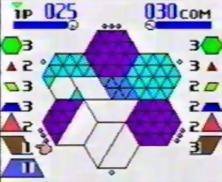
A game in progress
This is a picture of a game, midgame, with the timer on. There are going to be leftover pieces in this match, I wonder who won… As the board fills up more, playing pieces gets harder and harder. Note how 1P can’t use that large trapezoid to take the lower left 30-point hex because of that one empty triangle on the upper side And if 1P played to fill it, the computer would surely play something to block the move.

The lower right shot on the back of the box shows a game nearing the end. As you reach the end of the match, the stakes get high — both players are trying hard to play as many pieces as possible, without trying to keep the other player from being able to play as many pieces as you can. You need to carefully consider each move, not only in terms of how many points you will get from it, but for what new moves it allows the enemy to do and whether they’ll be able to play pieces you’d rather they different — one of the best ways to win is to stick the computer with large pieces they can’t play and watch them lose points for it. Look at all possible moves, and judge which will get you the most points and, in later parts, cost the other player the most points and moves. It’s a complicated, strategic game, and that’s what I love about it — you have to think while playing this game. I love it.
In conclusion, Level game mode really is my favorite thing about Hexcite for the Game Boy. I really like the addition of progression and levels to a game like this, it’s a great idea and works very well. Because of how you advance levels, through having to string together several wins in a row in order to advance, getting through the higher levels is challenging. It took me a long time to advance from rank B to rank A! I finally did it after many tries, but even if this is the “easy” version of Hexcite, it still provides a sometimes stiff challenge.
After reaching max rank in Level Game mode and thus beating the game, unfortunately I got next to no in-game reward, but I thought it was well worth it anyway because of how great the game is! It’s a fantastic game. After accomplishing that I learned about the Grand Master AI difficulty level, which unfortunately is only in Single Player and not Level Game mode. Very odd omission there. You have to win five times in a row (without saving) at Master difficulty in order to unlock it, which is a good challenge. I did that and tried that hardest difficulty. Grand Master is a bit harder than Master difficulty, but it’s only a moderate step up really, and the AI strategies I’d come up with still worked, so I didn’t find it that much more challenging to beat. Because of the games’ less exploitable AI the PC Hexcite game even at Medium felt at least as hard as GB Hexcite in Master; Hexcite is a tough game which requires a lot of thought to do well at!
Overall, I wish that GBC Hexcite had a better ending once you get a max rank in Level Game mode, and perhaps also that the AI at higher levels wasn’t quite as exploitable, but this is a really fantastic game I highly recommend. Hexcite is an incredible handheld game, and should be on any list of the best Game Boy and Game Boy Color games. Some version of Hexcite really is a must-try for any strategy or puzzle game fan, and while it has some drawbacks, GBC Hexcite also has some great exclusive features. I love it. The game gets a solid A score. It is as good as I can imagine a Game Boy version of Hexcite being.
Hexcite (PC Digital Download, 2007)
https://www.bdstudiogames.com/hexcite.html
——————–
Beyond the GBC version, there are also Japanese Wonderswan and Game Boy Color versions, but the most accessible version for Westerners is the PC version, which is available only on Bigfish Games’s website as a download-only title, and I did purchase a while after falling in love with the GB/C game. (Note, Bigfish Games eventually changed names to BD Studio Games, hence the link above.) It’s better than the GBC version in some ways, and worse in others. The basic gameplay is still Hexcite, so I won’t explain how it plays, I’ll just mention the differences versus the GBC game above. This is what a game screen looks like.
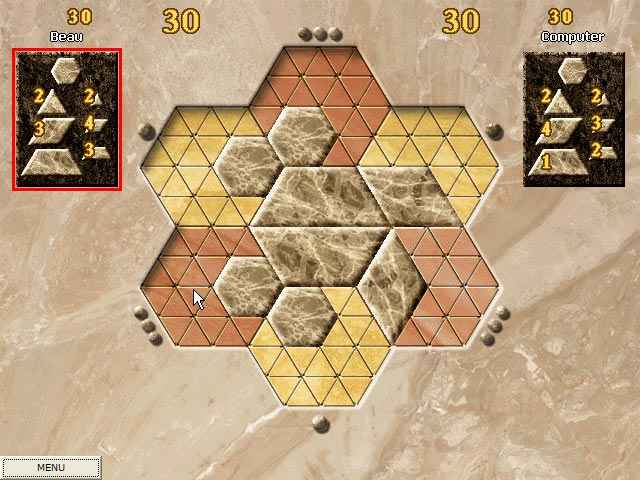
Yes, it’s Hexcite, but on the PC! Here are the details.
-The game is clearly fairly low-budget, and has simplistic menus, few options, and limited stat saving.
-It’s got no Level Game mode, only an equivalent of One Player and Practice, as well as options. Practice works just like on the GB, solve puzzles. Match Game is the main game mode, and in that you choose your difficulty level, number of rounds, game mode, etc, and then go. The game does keep track of your stats, such as number of wins and losses, best wins and losses, etc, but it doesn’t have anything beyond that in terms of progression. Still, the very limited options are disappointing and hurt the games’ longevity.
-Multiplayer is local-only, so don’t expect online play. Cheap and lazy stuff here.
-No saving a game in progress, I believe. Again, disappointing.
-A new, shorter Hexcite game variety is added, Hexcite ES. In this you just play in one hexagon, broken up into six triangular areas which act like the hexagons in regular Hexcite — eg. you get the point bonuses for filling in each of the six triangles that make up the large hexagon. There is no empty center space here. Because of the smaller board, you have fewer pieces in this game, as the larger pieces aren’t available in ES mode. ES mode is fun for a little while, but is probably less fun than the main game because the smaller, less complex board means that there isn’t quite as much to the game. It’s an interesting option and does shorten games, but I didn’t play this much before returning to normal Hexcite.
-There are 10 or so music tracks to choose from, 13 boards, and 13 tilesets, for regular Hexcite. There is some nice variety there for sure. Hexcite ES has just two boards and two tilesets. Hexcite ES isn’t in the GBC game, though, so it’s nice to have the additional mode! Still, ES should have had more tilesets and boards, I think. Sure, most people will probably mostly play the standard mode, but why the huge disparity? As for boards, the different tileset options are cool; on GBC and SGB you have many color-palette options, but the basic look of the tiles (color aside) is always the same. With the better graphics of a PC, you can have greater graphical variety, and you see that here. The game looks almost too big blown up to a full PC screen, though… I’m used to the whole board fitting on to a GBC screen! :p
-There are just three difficulty levels, which means there are a lot fewer difficulty levels than in the GB version, and no difficulty gradient here such as the one in Level Game mode, which has many more difficulty tiers as explained above. This really is unfortunate. PC Hexcite’s Beginner mode is not challenging, but Intermediate is tough, and there’s nothing between that and Beginner. This can get frustrating. Other than that, options are similar. I did find Intermediate surprisingly challenging compared to the GBC game, perhaps because many of the strategies I was using to win on the GB/C (at any difficulty level) weren’t working as well on the PC. The harder AI is great, but I liked winning too, so both ways have their advantages. :p It would be best to have a Hexcite game with as many difficulty level options as the GBC, and also the challenge of the PC game, but unless the GBA version is like that (no, I still don’t have it; I need to import that sometime!), that doesn’t exist. Ah well.
-No long pauses while waiting for the computer to play like in GB Hexcite. 🙂 It’s nice to have AI that plays so much faster. Processor power has its benefits. This is probably also why the AI is so tough.
Overall, it’s a fine version. The graphics and piece options are nice. I just wish it had some more modes, and this is a perfect handheld game… still though, it’s pretty cool that it exists. 🙂 Hexcite is great fun; I like strategy games, and this is a fun strategy board game. This, Blokus, Callisto — block-placement strategy board games like this are fantastic! I haven’t played Hexcite nearly as much in the last few years as I did back in 2011 when I was so hooked to the GBC game, but still, it’s a very good game. This game has much lower production values than the GBC game, and the only major gameplay addition is the challenge level of the AI. The better graphics and ES mode are nice, but those are just cosmetic differences. Overall, I had more fun with the GBC version. Maybe it’s because I played it first, but also I love the Level Game concept, and its absence hurts the PC game. The cheap presentation and missing features — saving fewer stats, no saving a game in progress, few difficulty levels, etc — hurt the game. I give it a B, maybe a B+ at most; the B+ might be a bit high, considering that I was hooked to the GBC game for the better part of a year but have only quite infrequently played the PC game, but the base gameplay is the same, so the basics are pretty great. On any platform Hexcite is very good. B or maybe B+.
